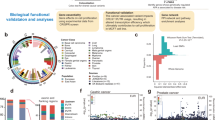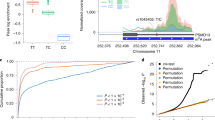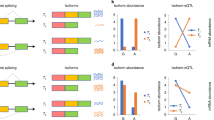Abstract
Genome-wide association studies have identified thousands of noncoding variants associated with human traits and diseases. However, the functional interpretation of these variants is a major challenge. Here, we constructed a multi-tissue atlas of human 3′UTR alternative polyadenylation (APA) quantitative trait loci (3′aQTLs), containing approximately 0.4 million common genetic variants associated with the APA of target genes, identified in 46 tissues isolated from 467 individuals (Genotype-Tissue Expression Project). Mechanistically, 3′aQTLs can alter poly(A) motifs, RNA secondary structure and RNA-binding protein–binding sites, leading to thousands of APA changes. Our CRISPR-based experiments indicate that such 3′aQTLs can alter APA regulation. Furthermore, we demonstrate that mapping 3′aQTLs can identify APA regulators, such as La-related protein 4. Finally, 3′aQTLs are colocalized with approximately 16.1% of trait-associated variants and are largely distinct from other QTLs, such as expression QTLs. Together, our findings show that 3′aQTLs contribute substantially to the molecular mechanisms underlying human complex traits and diseases.
This is a preview of subscription content, access via your institution
Access options
Access Nature and 54 other Nature Portfolio journals
Get Nature+, our best-value online-access subscription
$29.99 / 30 days
cancel any time
Subscribe to this journal
Receive 12 print issues and online access
$209.00 per year
only $17.42 per issue
Buy this article
- Purchase on Springer Link
- Instant access to full article PDF
Prices may be subject to local taxes which are calculated during checkout







Similar content being viewed by others
Data availability
Raw GTEx RNA-seq and genotype files are available to authorized users through dbGaP release, under accession no. phs000424.v7.p2. A list of 3′aQTLs, lead 3′aQTLs and their associated APA genes, isoform usage-controlled 3′aQTLs and expression-controlled 3′aQTLs are freely available at Synapse (accession no. syn22236281; https://doi.org/10.7303/syn22236281). Raw and processed PAC-seq data for the LARP4-depletion experiment have been deposited with the Gene Expression Omnibus under accession no. GSE139548. The proteomics data have been deposited with the MassIVE database under accession no. MSV000087000. A website portal dedicated to trait- and disease-associated 3′aQTLs can be accessed at https://wlcb.oit.uci.edu/3aQTL/index.php. Source data are provided with this paper.
Code availability
The open-source DaPars v.2.0 program is freely available at https://github.com/3UTR/DaPars2.
References
GTEx Consortium.Genetic effects on gene expression across human tissues. Nature 550, 204–213 (2017).
Gamazon, E. R. et al. Using an atlas of gene regulation across 44 human tissues to inform complex disease- and trait-associated variation. Nat. Genet. 50, 956–967 (2018).
Mayr, C. Regulation by 3′-untranslated regions. Annu. Rev. Genet. 51, 171–194 (2017).
Tian, B. & Manley, J. L. Alternative polyadenylation of mRNA precursors. Nat. Rev. Mol. Cell Biol. 18, 18–30 (2017).
Mayr, C. What are 3′ UTRs dDoing? Cold Spring Harb. Perspect. Biol. 11, a034728 (2018).
Masamha, C. P. et al. CFIm25 links alternative polyadenylation to glioblastoma tumour suppression. Nature 510, 412–416 (2014).
Weng, T. et al. Cleavage factor 25 deregulation contributes to pulmonary fibrosis through alternative polyadenylation. J. Clin. Invest. 129, 1984–1999 (2019).
Park, H. J. et al. 3′ UTR shortening represses tumor-suppressor genes in trans by disrupting ceRNA crosstalk. Nat. Genet. 50, 783–789 (2018).
Yoon, O. K., Hsu, T. Y., Im, J. H. & Brem, R. B. Genetics and regulatory impact of alternative polyadenylation in human B-lymphoblastoid cells. PLoS Genet. 8, e1002882 (2012).
Zhernakova, D. V. et al. DeepSAGE reveals genetic variants associated with alternative polyadenylation and expression of coding and non-coding transcripts. PLoS Genet. 9, e1003594 (2013).
Stacey, S. N. et al. A germline variant in the TP53 polyadenylation signal confers cancer susceptibility. Nat. Genet. 43, 1098–1103 (2011).
Higgs, D. R. et al. α-Thalassaemia caused by a polyadenylation signal mutation. Nature 306, 398–400 (1983).
van der Maarel, S. M., Tawil, R. & Tapscott, S. J. Facioscapulohumeral muscular dystrophy and DUX4: breaking the silence. Trends Mol. Med. 17, 252–258 (2011).
Fahiminiya, S. et al. A polyadenylation site variant causes transcript-specific BMP1 deficiency and frequent fractures in children. Hum. Mol. Genet. 24, 516–524 (2015).
Garin, I. et al. Recessive mutations in the INS gene result in neonatal diabetes through reduced insulin biosynthesis. Proc. Natl Acad. Sci. USA 107, 3105–3110 (2010).
Hellquist, A. et al. The human GIMAP5 gene has a common polyadenylation polymorphism increasing risk to systemic lupus erythematosus. J. Med. Genet. 44, 314–321 (2007).
Graham, R. R. et al. Three functional variants of IFN regulatory factor 5 (IRF5) define risk and protective haplotypes for human lupus. Proc. Natl Acad. Sci. USA 104, 6758–6763 (2007).
Cannavò, E. et al. Genetic variants regulating expression levels and isoform diversity during embryogenesis. Nature 541, 402–406 (2017).
Mariella, E., Marotta, F., Grassi, E., Gilotto, S. & Provero, P. The length of the expressed 3′ UTR is an intermediate molecular phenotype linking genetic variants to complex diseases. Front. Genet. 10, 714 (2019).
Xia, Z. et al. Dynamic analyses of alternative polyadenylation from RNA-seq reveal a 3′-UTR landscape across seven tumour types. Nat. Commun. 5, 5274 (2014).
Stegle, O., Parts, L., Piipari, M., Winn, J. & Durbin, R. Using probabilistic estimation of expression residuals (PEER) to obtain increased power and interpretability of gene expression analyses. Nat. Protoc. 7, 500–507 (2012).
Shabalin, A. A. Matrix eQTL: ultra fast eQTL analysis via large matrix operations. Bioinformatics 28, 1353–1358 (2012).
Bogard, N., Linder, J., Rosenberg, A. B. & Seelig, G. A deep neural network for predicting and engineering alternative polyadenylation. Cell 178, 91–106.e23 (2019).
Kwan, T. et al. Genome-wide analysis of transcript isoform variation in humans. Nat. Genet. 40, 225–231 (2008).
Hoarau, J.-J., Cesari, M., Caillens, H., Cadet, F. & Pabion, M. HLA DQA1 genes generate multiple transcripts by alternative splicing and polyadenylation of the 3′ untranslated region. Tissue Antigens 63, 58–71 (2004).
Cunninghame Graham, D. S. et al. Association of IRF5 in UK SLE families identifies a variant involved in polyadenylation. Hum. Mol. Genet. 16, 579–591 (2007).
Sheng, G., dos Reis, M. & Stern, C. D. Churchill, a zinc finger transcriptional activator, regulates the transition between gastrulation and neurulation. Cell 115, 603–613 (2003).
Lyons, J. J. et al. Elevated basal serum tryptase identifies a multisystem disorder associated with increased TPSAB1 copy number. Nat. Genet. 48, 1564–1569 (2016).
Yang, J., Lee, S. H., Goddard, M. E. & Visscher, P. M. GCTA: a tool for genome-wide complex trait analysis. Am. J. Hum. Genet. 88, 76–82 (2011).
Wang, G., Sarkar, A., Carbonetto, P. & Stephens, M. A simple new approach to variable selection in regression, with application to genetic fine mapping.J. R. Stat. Soc. Series B Stat. Methodol. 82, 1273–1300 (2020).
Urbut, S. M., Wang, G., Carbonetto, P. & Stephens, M. Flexible statistical methods for estimating and testing effects in genomic studies with multiple conditions. Nat. Genet. 51, 187–195 (2019).
Cingolani, P. et al. A program for annotating and predicting the effects of single nucleotide polymorphisms, SnpEff: SNPs in the genome of Drosophila melanogaster strain w1118; iso-2; iso-3. Fly (Austin) 6, 80–92 (2012).
Li, Y. I. et al. RNA splicing is a primary link between genetic variation and disease. Science 352, 600–604 (2016).
Sun, B. B. et al. Genomic atlas of the human plasma proteome. Nature 558, 73–79 (2018).
Thomas, L. F. & Sætrom, P. Single nucleotide polymorphisms can create alternative polyadenylation signals and affect gene expression through loss of microRNA-regulation. PLoS Comput. Biol. 8, e1002621 (2012).
Lee, J. Y., Yeh, I., Park, J. Y. & Tian, B. PolyA_DB 2: mRNA polyadenylation sites in vertebrate genes. Nucleic Acids Res. 35, D165–D168 (2007).
Sun, H. S. et al. A polymorphic 3′UTR element in ATP1B1 regulates alternative polyadenylation and is associated with blood pressure. PLoS ONE 8, e76290 (2013).
Alipanahi, B., Delong, A., Weirauch, M. T. & Frey, B. J. Predicting the sequence specificities of DNA- and RNA-binding proteins by deep learning. Nat. Biotechnol. 33, 831–838 (2015).
Matoulkova, E., Michalova, E., Vojtesek, B. & Hrstka, R. The role of the 3′ untranslated region in post-transcriptional regulation of protein expression in mammalian cells. RNA Biol. 9, 563–576 (2012).
Bava, F.-A. et al. CPEB1 coordinates alternative 3′-UTR formation with translational regulation. Nature 495, 121–125 (2013).
Müller-McNicoll, M. et al. SR proteins are NXF1 adaptors that link alternative RNA processing to mRNA export. Genes Dev. 30, 553–566 (2016).
Chen, P.-F., Hsiao, J. S., Sirois, C. L. & Chamberlain, S. J. RBFOX1 and RBFOX2 are dispensable in iPSCs and iPSC-derived neurons and do not contribute to neural-specific paternal UBE3A silencing. Sci. Rep. 6, 25368 (2016).
Gruber, A. J. et al. A comprehensive analysis of 3′ end sequencing data sets reveals novel polyadenylation signals and the repressive role of heterogeneous ribonucleoprotein C on cleavage and polyadenylation. Genome Res. 26, 1145–1159 (2016).
Dominguez, D. et al. Sequence, structure, and context preferences of human RNA binding proteins. Mol. Cell 70, 854–867.e9 (2018).
Wan, Y. et al. Landscape and variation of RNA secondary structure across the human transcriptome. Nature 505, 706–709 (2014).
Yang, R. et al. La-related protein 4 binds poly(A), interacts with the poly(A)-binding protein MLLE domain via a variant PAM2w motif, and can promote mRNA stability. Mol. Cell. Biol. 31, 542–556 (2011).
Routh, A. et al. Poly(A)-ClickSeq: click-chemistry for next-generation 3′-end sequencing without RNA enrichment or fragmentation. Nucleic Acids Res. 45, e112 (2017).
Pickrell, J. K. Joint analysis of functional genomic data and genome-wide association studies of 18 human traits. Am. J. Hum. Genet. 94, 559–573 (2014).
Finucane, H. K. et al. Partitioning heritability by functional annotation using genome-wide association summary statistics. Nat. Genet. 47, 1228–1235 (2015).
Dickson, J. R., Kruse, C., Montagna, D. R., Finsen, B. & Wolfe, M. S. Alternative polyadenylation and miR-34 family members regulate tau expression. J. Neurochem. 127, 739–749 (2013).
Locke, J. M., Da Silva Xavier, G., Rutter, G. A. & Harries, L. W. An alternative polyadenylation signal in TCF7L2 generates isoforms that inhibit T cell factor/lymphoid-enhancer factor (TCF/LEF)-dependent target genes. Diabetologia 54, 3078–3082 (2011).
Giambartolomei, C. et al. Bayesian test for colocalisation between pairs of genetic association studies using summary statistics. PLoS Genet. 10, e1004383 (2014).
Agarwal, V., Bell, G. W., Nam, J.-W. & Bartel, D. P. Predicting effective microRNA target sites in mammalian mRNAs. eLife 4, e05005 (2015).
Lewis, M. J. et al. UBE2L3 polymorphism amplifies NF-κB activation and promotes plasma cell development, linking linear ubiquitination to multiple autoimmune diseases. Am. J. Hum. Genet. 96, 221–234 (2015).
Wang, S. et al. A functional haplotype of UBE2L3 confers risk for systemic lupus erythematosus. Genes Immun. 13, 380–387 (2012).
Holleboom, A. G., Vergeer, M., Hovingh, G. K., Kastelein, J. J. & Kuivenhoven, J. A. The value of HDL genetics. Curr. Opin. Lipidol. 19, 385–394 (2008).
Kano, S. et al. The contribution of transcription factor IRF1 to the interferon-γ-interleukin 12 signaling axis and TH1 versus TH-17 differentiation of CD4+ T cells. Nat. Immunol. 9, 34–41 (2008).
Nanavaty, V. et al. DNA methylation regulates alternative polyadenylation via CTCF and the cohesin complex. Mol. Cell 78, 752–764.e6 (2020).
Mittleman, B. E. et al. Alternative polyadenylation mediates genetic regulation of gene expression. eLife 9, e57492 (2020).
Dobin, A. et al. STAR: ultrafast universal RNA-seq aligner. Bioinformatics 29, 15–21 (2013).
Quinlan, A. R. & Hall, I. M. BEDTools: a flexible suite of utilities for comparing genomic features. Bioinformatics 26, 841–842 (2010).
Lindenbaum, P. & Redon, R. bioalcidae, samjs and vcffilterjs: object-oriented formatters and filters for bioinformatics files. Bioinformatics 34, 1224–1225 (2018).
Storey, J. D. & Tibshirani, R. Statistical significance for genomewide studies. Proc. Natl Acad. Sci. USA 100, 9440–9445 (2003).
Hormozdiari, F., Kostem, E., Kang, E. Y., Pasaniuc, B. & Eskin, E. Identifying causal variants at loci with multiple signals of association. Genetics 198, 497–508 (2014).
Aerts, J. et al. Bayesian refinement of association signals for 14 loci in 3 common diseases. Nat. Genet. 44, 1294–1301 (2012).
Pruim, R. J. et al. LocusZoom: regional visualization of genome-wide association scan results. Bioinformatics 26, 2336–2337 (2010).
Purcell, S. et al. PLINK: a tool set for whole-genome association and population-based linkage analyses. Am. J. Hum. Genet. 81, 559–575 (2007).
Wagner, E. J. & Garcia-Blanco, M. A. RNAi-mediated PTB depletion leads to enhanced exon definition. Mol. Cell 10, 943–949 (2002).
Baillat, D., Russell, W. K. & Wagner, E. J. CRISPR–Cas9 mediated genetic engineering for the purification of the endogenous integrator complex from mammalian cells. Protein Expr. Purif. 128, 101–108 (2016).
Song, F. & Stieger, K. Optimizing the DNA donor template for homology-directed repair of double-strand breaks. Mol. Ther. Nucleic Acids 7, 53–60 (2017).
Elrod, N. D., Jaworski, E. A., Ji, P., Wagner, E. J. & Routh, A. Development of Poly(A)-ClickSeq as a tool enabling simultaneous genome-wide poly(A)-site identification and differential expression analysis. Methods 155, 20–29 (2019).
Routh, A. DPAC: a tool for differential poly(A)–cluster usage from poly(A)-targeted RNAseq data. G3 (Bethesda) 9, 1825–1830 (2019).
Acknowledgements
We thank L. Hou, Z. Cui and members of the Li laboratory for helpful discussions. This work was supported by a Computational Cancer Biology Training Program fellowship Cancer Prevention Research Institute of Texas (CPRIT) grant no. RP170593 (K.-L.H.), National Institutes of Health grants to W.L. (nos. R01HG007538, R01CA193466, R01CA228140), P.J. (no. R03CA223893), E.J.W. (no. R01GM134539) and a University of California, Irvine (UCI) Cancer Center support grant (no. P30CA062203). E.J.W. acknowledges support from University of Texas Medical Branch (UTMB) Department of Biochemistry and Molecular Biology startup funds and the Welch Foundation (no. H-1889). The UTMB Mass Spectrometry Facility is supported in part by CPRIT grant no. RP190682 (W.K.R.). We also thank I. Toufique and P. Papadopoulos at the UCI Research Cyber Infrastructure Center for high-performance computing support.
Author information
Authors and Affiliations
Contributions
L.L. and W.L. conceived and supervised the project. L.L., Y.G., Y.C., Y.E.C. and G.W. performed the data analyses. K.-L.H., N.D.E., W.K.R. and P.J. performed the experiments. L.L., Y.L., Y.C., F.P., E.J.W. and W.L. interpreted the data and wrote the manuscript.
Corresponding authors
Ethics declarations
Competing interests
The authors declare no competing interests.
Additional information
Peer review information Nature Genetics thanks Stephen Montgomery, Bin Tian and the other, anonymous, reviewer(s) for their contribution to the peer review of this work.
Publisher’s note Springer Nature remains neutral with regard to jurisdictional claims in published maps and institutional affiliations.
Extended data
Extended Data Fig. 1 Known technical covariates associated with inferred PEER factors in each tissue.
The R2 value in each cell represents the percentage of variance explained for each tissue/covariates pair. Only the most relevant sample-specific covariates were used. Gray color represents insufficient data to predict correlations. Each color code below indicates a tissue of origin.
Extended Data Fig. 2 Known donor covariates associated with inferred PEER factors in each tissue.
The R2 value in each cell represents the percentage of variance explained for each tissue/covariate pair. Only the most relevant donor-specific covariates were used. Gray color represents insufficient data to predict correlations. Each color code below indicates a tissue of origin.
Extended Data Fig. 3 PEER factors for gene expression associated with PEER factors for PDUI in each tissue.
The R2 value in each cell represents the correlation between the top PEER factors for gene expression (rows) and the most relevant PEER factors for PDUI for each tissue (columns). Each color code below indicates a tissue of origin.
Extended Data Fig. 4 Enrichment of 3′aQTL in different categories of mutagenesis variants annotations.
The enrichment score represents the log odd ratio and accessed by the program Torus. The x-axis represents three categories of variants with different effects in predicting APA isoform log fold change due to the variant. Each color code indicates a tissue of origin. The saturation mutagenesis data with log isoform fold change < 0.15 are not available from Bogard et al.
Extended Data Fig. 5 The sharing magnitude of 3′aQTLs using different FDRs at 0.01, 0.005, 0.001.
Histograms showing the estimated proportion of tissues that share lead 3′aQTLs /eQTLs, by magnitude, with other tissues, among all 46 examined tissues, among non-brain tissues only, and among brain tissues only.
Extended Data Fig. 6 sQTL have a distinct genomic distribution and functional enrichment compared with 3′aQTL.
a, Relative position distance between sQTL and their associated genes. TSS represents the transcription start site; TES represents the transcription end site. Red line represents randomly selected positions within the +/− 1Mb window for each gene. b, 3′aQTL and sQTL enrichment in functional annotations. The enrichment is shown as mean with SD across tissues. The proportion of variants was also included for 3′aQTL and sQTL. Data are presented as mean value +/− Standard deviation. n = 46 tissues examined.
Extended Data Fig. 8 Trans-regulator APA prediction.
a, Scatterplot of the percentage of distal polyA site usage index (PDUI) in CSTF2 over-expressed and low-expressed samples where mRNA significantly shortened (blue) or lengthened (red) are colored. b, Scatterplot of PDUI changes for LARP4 over-expressed and low-expressed samples were shown.
Extended Data Fig. 9 Representative genome browser images of the SLC9A3R2 gene.
SLC9A3R2 APA is regulated by LARP4 and binds LARP4, as assessed by LARP4 CLIP-seq.
Extended Data Fig. 10 A partitioned heritability plot for the percentage of phenotypic variance can be explained, for 35 traits, by 3′aQTLs, eQTLs, and sQTLs in aggregate.
The trait/tissue pairs with heritability not significantly greater than 0 are removed. Centre horizontal lines show median values, boxes span from the 25th percentile to the 75th percentile. Whiskers extend to 1.5 × IQR (bottom), where IQR is the interquartile range. n = 46 tissues examined.
Supplementary information
Supplementary Information
Supplementary Methods and Figs. 1–22
Supplementary Tables
Supplementary Tables 1–9
Source data
Source Data Fig. 5
Uncropped scans of all blots and gels.
Rights and permissions
About this article
Cite this article
Li, L., Huang, KL., Gao, Y. et al. An atlas of alternative polyadenylation quantitative trait loci contributing to complex trait and disease heritability. Nat Genet 53, 994–1005 (2021). https://doi.org/10.1038/s41588-021-00864-5
Received:
Accepted:
Published:
Issue Date:
DOI: https://doi.org/10.1038/s41588-021-00864-5
This article is cited by
-
Structured 3′ UTRs destabilize mRNAs in plants
Genome Biology (2024)
-
A distinct class of pan-cancer susceptibility genes revealed by an alternative polyadenylation transcriptome-wide association study
Nature Communications (2024)
-
Integration of apaQTL and eQTL analysis reveals novel SNPs associated with occupational pulmonary fibrosis risk
Archives of Toxicology (2024)
-
Identifying novel chemical-related susceptibility genes for five psychiatric disorders through integrating genome-wide association study and tissue-specific 3′aQTL annotation datasets
European Archives of Psychiatry and Clinical Neuroscience (2024)
-
Alternative polyadenylation regulates acetyl-CoA carboxylase function in peanut
BMC Genomics (2023)



